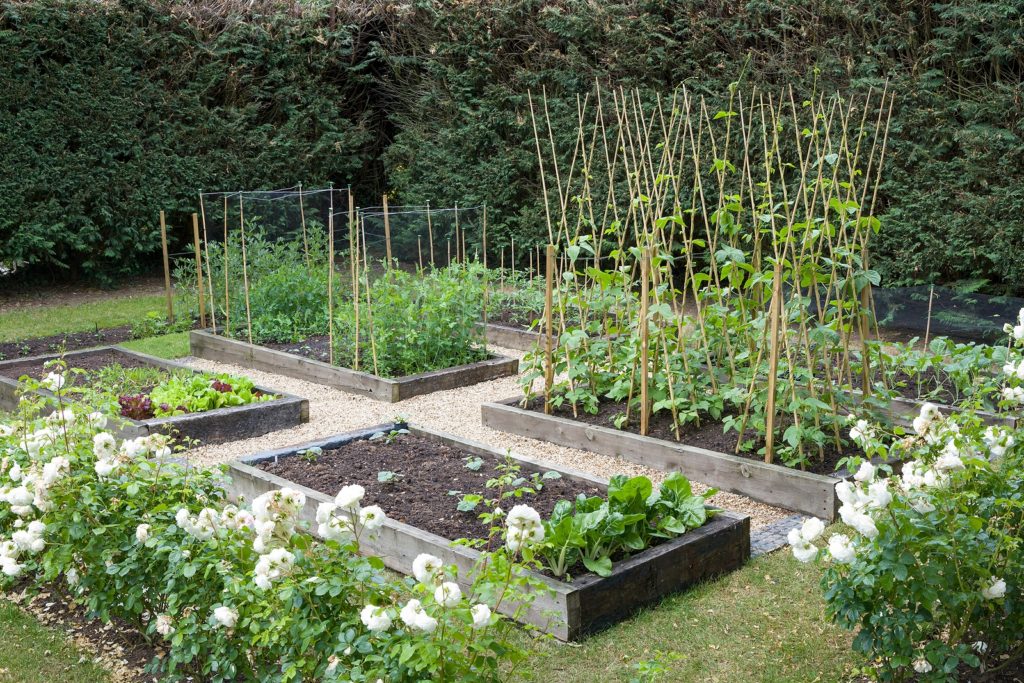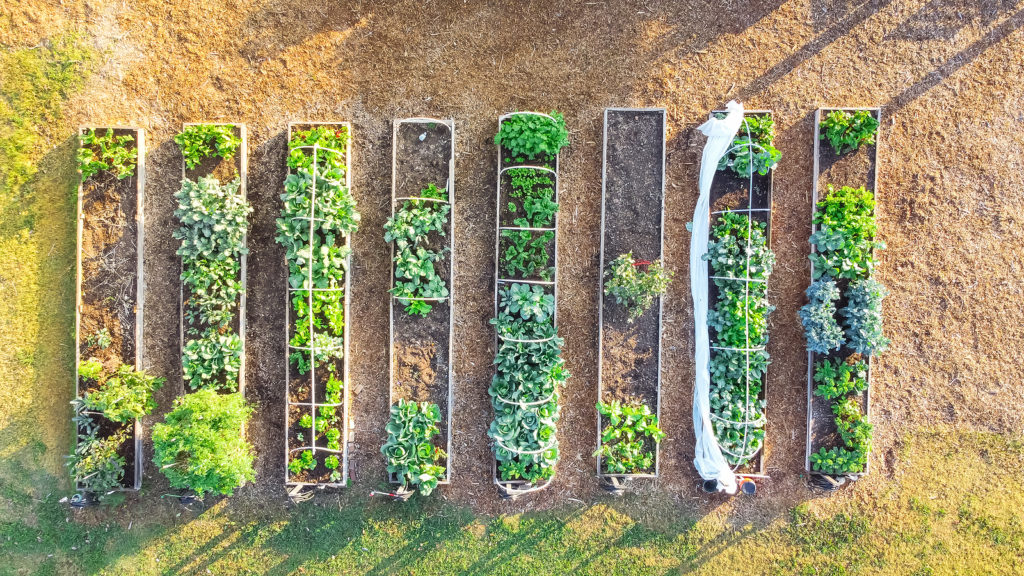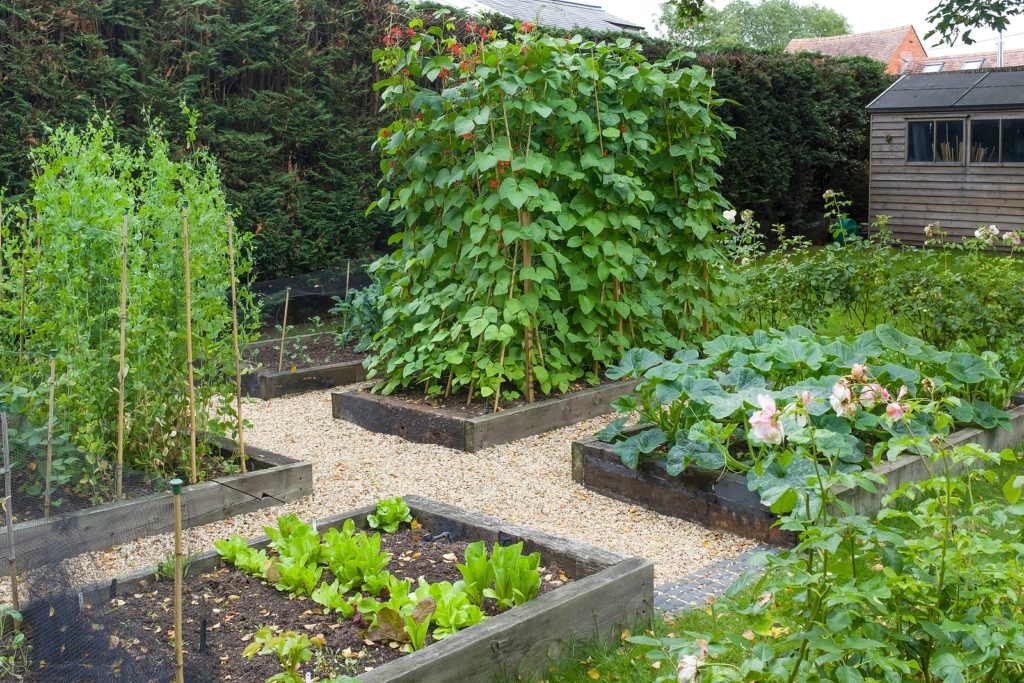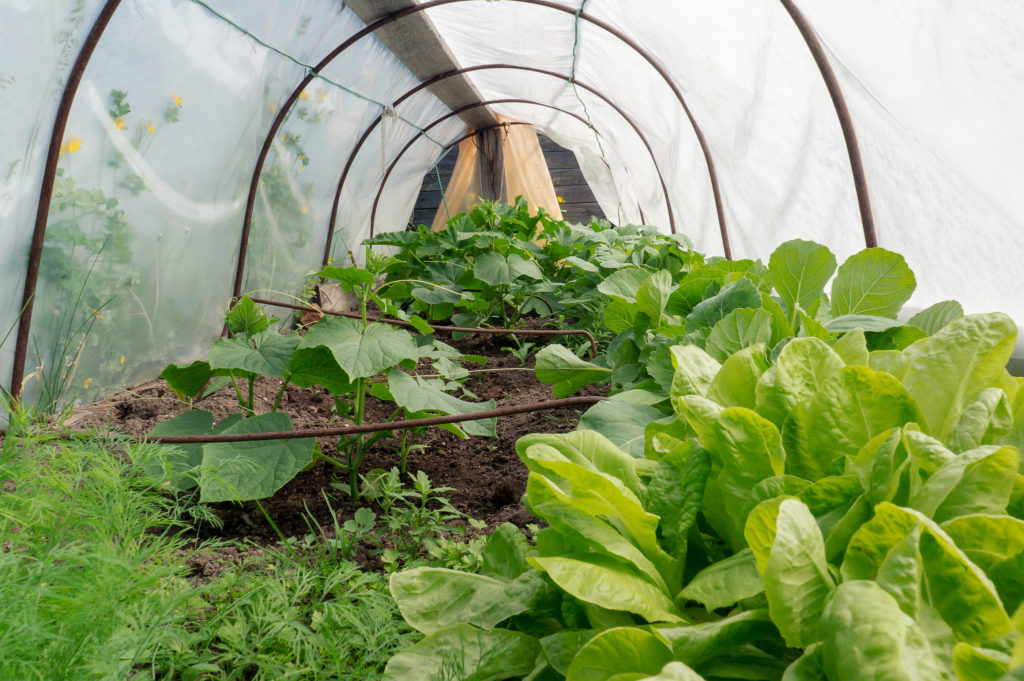Keep a vegetable garden calendar and map. Use the calendar to record when you start seeds when you plant in the garden, and when you expect to harvest each crop. Use the garden map to record where you plant each crop or plan to plant later in the season. Keeping track of the garden in your head is next to impossible.
A large calendar with extra space each day for record keeping is ideal. Keep the calendar in the garden shed or next to the door that leads to the garden. Take a couple of minutes after each visit to the garden to jot down what you’ve attended to. The few minutes you take each day will pay off when harvest time or the next growing season rolls around.
Good Products for Raised Bed Growing at Amazon:
- Galvanized Raised Bed 8×3
- Cedar Raised Bed 4×8
- Elevated Cedar Planter 4×2
- Walk-In Greenhouse Tunnel 15x7x7
- Row Cover for Freeze Protection 10×30
In addition to a calendar, a vegetable garden map will help you keep track of where each crop is planted. A simple drawing on graph paper is all you really need. Lay out rows and beds and note important details such as shade from nearby buildings or trees, breezy areas, and extra wet or dry spots in the garden. You can use trace paper set over your map to plan out succession crops and crop rotations. Your garden map and overlays should note early, midseason, and late plantings–the rows and beds.

Vegetable garden calendar items
- Seed sown and transplants planted. Also, note varieties and quantities. Note the rows on your garden map. Your record can include where and when you bought seeds and starts and how much they cost.
- Expected harvest times: Count ahead the days to maturity for each crop and note on the calendar the anticipated harvest time for each crop sown today. This will help you harvest your crops at the peak of maturity.
- Planting preparation: soil tilling or digging, amendments added to the garden, mulching, and staking.
- Watering and rainfall: note irrigation and rainfall so that you don’t over or underwater. Keep track of rainfall–note the extent of storms and the number of inches of rain in the garden.
- Feeding and fertilizing: note the type of fertilizer used and the amount.
- Weeding: which weeds grew in the garden and when. How did you get rid of them?
- Pest and disease control; pests and diseases found in the garden and how you dealt with them. Note biological controls–beneficial insects–and garden practices that have worked in the garden. Pests and diseases often come in cycles–a calendar can help you anticipate future problems.
- Weather and temperature. Noting the weather and temperature regularly may help answer questions that come up later in the season. (Rainy or cold weather at flowering time can impact pollination and harvest.)
- Harvest notes: which crops performed well and which didn’t? How much did each crop produce–the yield. Note the amounts used for canning and freezing–the pints and quarts yield. Note varieties to plant again in coming seasons.
- Crop placement and rotation: use your garden map alongside your calendar to plan ahead. Planning succession crops throughout the season–which crops are short-staying and which are long-staying–will help you get the most out of your garden.
- Soil records: note the pH in differing areas around the garden and what amendments you’ve added to the soil.
- Frost and freeze dates and season extension efforts. When did the cold weather begin and end? When did you use plastic tunnels or row covers to protect the crops?
- Garden cleanup: when did crops come out of the garden and what extra effort was made to end the season or prepare for next season? Was compost or manure added to the garden? Were cover crops planted?
A garden calendar and map are useful tools. But there are other ways to keep track of the garden. A spiral notebook or file cards may work just as well. The important thing is to keep track of the garden and to note your efforts and successes.

Month-by-month vegetable garden calendar
One of the most challenging aspects in gardening is to get things started at the proper time. Success in the garden often depends on timing.
Planning the work ahead is important. A simple checklist can be used to make sure that everything is started and carried out at the proper time–starting in spring with preparing the ground and the sowing of seeds.
Here is a month-by-month calendar of operations for the vegetable garden. Use this checklist as a timely reminder of things to be done or as the basis for your own checklist. Keep your schedule of garden reminders in a loose-leaf notebook with a section for each month. A binder notebook will allow you to make changes and add information. You can add to and modify this calendar from year to year, and you can post the calendar for the month in the garden or in the garden shed.
January
Probably one of the good resolutions made with the New Year is a better garden for the coming season. Psychologists say that the only hope for resolutions is to nail them down at the start with an action–that seems to have more effect in making an actual impression on the brain. So January is a good time to send seed catalogs or start perusing them online.
- Planting Plan. Make a list of what you’re going to want to grow this year, and then make you can start to sketch out a garden or planting plan.
- Seeds. Order your seed. Order now while the seed grower’s stock is full and before the spring rush.
- Manures and compost. If you have a place under cover where you can collect manure and compost for the coming season, do it now, or if the weather allows, add these to your garden now–simply sheet compost, that is spread an inch or two of compost or manure across the planting beds. Soil amendments can often be gotten less expensive at this time of year. If possible, add compost and rock phosphate now to allow for several turnings or for the rain and weather to carry these deep into the soil.
- Cold frames. If you use cold frames or plastic tunnels be sure to open them up and air them out on warm days. Practically no water will be needed in frames or tunnels, but if the soil does dry out sufficiently to need it, apply early on a bright morning.
- Onions. It’s not too early, this month, to sow onions indoors (greenhouse or kitchen counter) for spring transplanting outside. Try Prizetaker, Ailsa Craig, Mammoth Silver-skin, or Gigantic Gibraltar.
- Lettuce. Sow lettuce for spring crops indoors or in cold frames or plastic tunnels.
- Fruit. This is a good month to prune grapes, currants, gooseberries, and peach trees. Dormant spray fruit trees and roses on a clear, windless day.
- More January tips at: January Vegetable Garden and Seed Starting in January.
February
- Cold frames and hotbeds. Get all your material ready — select lumber and materials to make new frames. Make sure portable frames are ready to go and sashes and covers are in good repair.
- Starting seeds. The first part of the month, start seeds indoors or in the greenhouse or hot frame: earliest planting of cabbage, cauliflower, and lettuce should be made; then two to four weeks later for main crop cabbage family members. At this time also, beets and earliest celery and Brussels sprouts can be sown indoors or in frames (or outside if you live in a mild winter region).
- •Tools. Check and clean them all now; order repairs.
- Poles and trellises. Get your wire trellis and planting poles in order or get new supplies for the coming season.
- Fruit. Finish up last month’s pruning and dormant spraying, if not all done. Also, examine plum and cherry trees for overwintered pests or diseases.
- More February Tips at February Vegetable Garden and Seed Starting Vegetables in February.
March
- Plastic tunnels and cold frames. Get season-extending plastic tunnel and cold frames in place now. Some of the seeds sown indoors last month will be ready for transplanting and going into the frames and tunnels; also lettuce sown in January. Radish and carrot may be sown in alternating rows in beds covered with plastic tunnels. Give plenty of air and water to seedlings on bright mornings; be careful not to have them caught by suddenly cold nights after a bright warm day.
- Seed-sowing indoors. Last indoor sowing of early cabbage and early summer cabbages, lettuce, rhubarb (for seedling plants), cauliflower, radish, spinach, turnip, and early tomatoes; towards the end of the month, sow seed for late-season tomatoes and first of lima beans, cucumber, squash, peppers, and eggplant. Start main crop tomatoes in frames. Sprout early potatoes in the sand.
- Planting, outside. If there is an early spring and the ground is workable and sufficiently dry, sow onions, lettuce, beet, radish, smooth peas, early carrot, cabbage, leek, celery (main crop), and turnip. Set out new beds of asparagus and rhubarb. Manure and fork up old beds and lay down an inch or two of aged compost.
- • Fruit. Prune now, apple, plum, and pear trees. And this is the last chance for lime-sulfur and dormant oil sprays.
- More tips for March at: March Vegetable Garden and Seed Starting Vegetables in March.
April
- Coldrame. These will keep aphids or whiteflies from getting a foothold in the frame. Almost every day the top should be lifted and aired. Take care that seed starting pots and flats do not dry out–check both in the morning and late afternoon. Air and water are simple preventatives for keeping insect pests and diseases at bay.
- Seed sowing. In the greenhouse, hot frame, or indoors, sow seeds of tomato, eggplant, peppers, muskmelon, and watermelon. Also this month sow, corn, cucumbers, melons, early squash, and lima beans for transplanting out at the end of May or in early June.
- Planting outside. Plant in seed beds celery, cabbage, lettuce, onions, carrots, smooth peas, spinach, beets, chard, parsnip, turnip, and radish. Set out lettuce and cabbage plants. If not put in last month, sow also parsnip, salsify, parsley, wrinkled peas, and endive; toward the end of this month (or the first part of next) do a second planting of these. Set out plants of early cabbage, lettuce, onion sets, sprouted potatoes, and beets.
- In the garden. Cultivate between rows of sowed crops; get rid of weeds by hand just as soon as they appear and keep an eye out for cutworms and root maggots.
- Fruit. Thin out all old blackberry canes, dewberry, and raspberry canes (if this was not done last summer or fall; it’s best to do this directly after the fruiting season). Set out new strawberry beds, small fruits, and fruit trees.
- More April garden tips at: April Vegetable Garden and Seed Starting Vegetables in April.
May
- Weeding. Keep ahead of the weeds; this is the month when warm days and gentle rains allow weeds to grow by leaps and bounds. Don’t let sprouting onions, beets, and carrots get overtaken by rapid-growing weeds. A slight hilling of crops at planting time will set sprouting weeds apart from your vegetables.
- Frames and tunnels. Guard tender plants growing in frames or plastic tunnels–tomatoes, eggplant, and peppers–against sudden late frosts. The cover may be left off most of the time, but keep your eye on the weather forecast. As needed, water crops in the frame keeping the soil just moist.
- Planting outside. The first part of the month: early beans, early corn, okra, and late potatoes may sown or transplanted out into the garden; and first tomatoes set out–even if a few are lost–they are readily replaced. Finish transplanting out cabbage, lettuce, cauliflower, and beets from frames. As soon as the weather warms: sow in the garden or set out starts of beans, lima beans, muskmelon, watermelon, summer squash, peas, potatoes, lettuce, radish, tomatoes, corn, kale, winter squash, pumpkins, pole limas, and cucumbers.
- More May garden tips at: May Vegetable Garden and Garden Tips for May.

June
- Weeds. Keep up frequent, shallow cultivation in planting beds–knock down weeds early!
- Seeds and starts. Early in the month, sow beans, wax beans, lima beans, pole beans, melons, corn, cucumber, peas, New Zealand spinach, and summer lettuce. Set out starts of eggplant, pepper, and main-crop tomatoes. Make successive crops of lettuce, radish, carrots, and spinach. Lightly moisten the soil before sowing, then firm seeds in. Mid-month plant beans, corn, peas, turnip, summer lettuce, radish, late cabbage, and set out late-season tomato plants. Toward the end of the month set out celery and late cabbage.
- Maintenance. Top-dress growing crops with aged compost. Prune tomatoes, and cut out excess foliage for early tomatoes. If you didn’t put cages of poles in place at planting time, do it now before tomatoes develop roots in earnest.
- Fall crops. Sow beans, beets, corn, and other early fall crops. Allow asparagus to grow ferny tops.
- More June garden tips at: June Vegetable Garden and Garden Tips for June.
July
- Planting. Set out late cabbage, cauliflower, broccoli, leeks, and celery. Early in the month sow beans, beets, endive, kale, lettuce, radish, winter cabbage, cauliflower, Brussels sprouts, and celery plants. Mid-month sow beans, early corn, and early peas for late fall crops and successions of lettuce and radish. Irrigate as needed.
- Fruit. Pinch back new canes of blackberry, dewberry, and raspberry. Rub off the second crop of buds on grapes. Thin out if too many bunches of grapes; also on plums, peaches, and other fruit thin too thick or touching fruits.
- Seed start fall harvest crops. Sow indoors or directly in the garden fall harvest cool-weather crops: leafy crops and roots. Sow Brussels sprouts, broccoli, cabbage, and leeks.
- More tips for July at July Vegetable Garden and Garden Tips for July.
August
- Weeds. Keep the garden clean from late weeds–especially purslane, the hot-weather weeds which should be always removed from the garden.
- Planting. Sow spinach, rutabaga, turnip, bush beans, and peas for the last fall crop. During the first part of the month, late celery may still be put out. Sow early peas, lettuce, and radish for early fall crops, indoors or in frames or tunnels.
- More tips for August at August Vegetable Garden and Garden Tips for August.
September
- Frames and tunnels. Transplant out lettuce started in August. Sow radishes, onions, and successive crops of lettuce. Protect tender crops from cold nights; keep an eye on the weather forecast.
- Harvest and store. Harvest onions. Get squash under cover before frost. Sow spinach and onions for wintering over. Sow a cover crop of rye as spots in the garden are cleared of summer crops.
- Sow cool-season crops. Leaf and root crops can be seed started now in a cold frame or plastic tunnel for winter harvest.
- More September tips at September Vegetable Garden and Garden Tips for September.

October
- Get ready for winter. Gather tomatoes, melons, and summer crops to keep as long as possible. Keep especially clean and well-cultivated all crops to be wintered over.
- Frame and tunnels. Sow in frame or tunnel quick-maturing cool-weather crops such as cut-and-come-again lettuce or beets or turnips for harvest before or during winter. Grow over-wintering crops to near maturity before daylight dips below 10 hours a day in mid-November. Protect these crops through the winter in the frame.
- Store. Late in the month store cabbage and cauliflower; also beets, carrots, and other root crops. Get boxes, barrels, bins, sand, or sphagnum moss ready beforehand, to save time in packing.
- Clean the garden. Store poles and trellis for use next year. Clean garden beds of spent plants and debris as crops come in. Don’t give pests and diseases a place to over winter. Spread aged compost across planting beds as they are cleared.
- Fruit. Harvest apples and other fruits. Pick winter pears just before hard frosts, and store in a dry dark place.
- More October garden tips at October Kitchen Garden Almanac and Garden Tips for October.
November
- Frames. Make deep hotbeds for winter lettuce and radishes. Construct frames for use next spring. See that vegetables in cellar, bins, and sheds are safe from freezing. If you live where the ground freezes, take in root crops if any remain in the ground unprotected by a frame, except, of course, parsnip and salsify for spring use. Put aged manure on asparagus and rhubarb beds. Get straw mulch ready for spinach and kale to be wintered over if they are in exposed locations.
- Fruit. Obtain seedless hay for mulching strawberries. Cut out old wood of cane fruits such as blackberries if not done after gathering fruit. Look over fruit trees for borers.
- More November garden tips at: November Vegetable Garden.
December
- Mulch. Mulch crops that will be over-wintered in the garden with straw or seedless hay. Use only light, loose material at first, gradually covering plants for winter as temperatures drop. Put mulch on spinach and kale and over salsify and parsnips.
- Seed starting and planning. If you live in a mild-winter region, you can start cool-season crops for harvest in spring and late spring. If you live in a cold-winter region make a list of crops you want to start indoors in January and February.
- Fruit. Mulch strawberries. Prune grape-vines. Make the first application of winter sprays for fruit trees.
- Compost. Add to and turn the compost pile before winter sets in. Any seed-free weeds or non-diseased garden waste can be added to the compost.
- More December garden tips at: December Vegetable Garden.
Related articles:
How to Start a Vegetable Garden
How to Grow a Fall Vegetable Garden
How to Grow a Winter Vegetable Garden
Garden Planning Books at Amazon:
- Vegetable Garden Almanac & Planner
- Kitchen Garden Grower’s Guide Vegetable Encyclopedia
- Vegetable Garden Grower’s Guide
- Tomato Grower’s Answer Book















